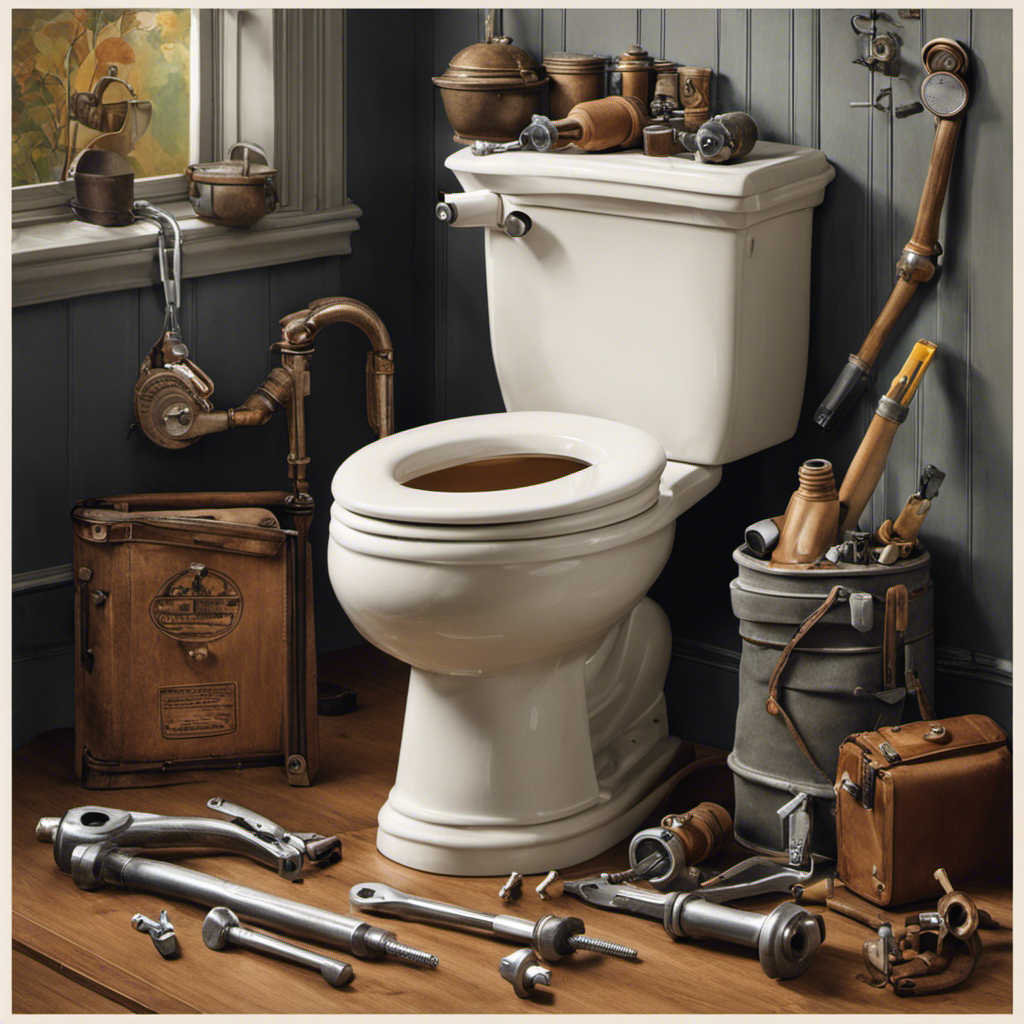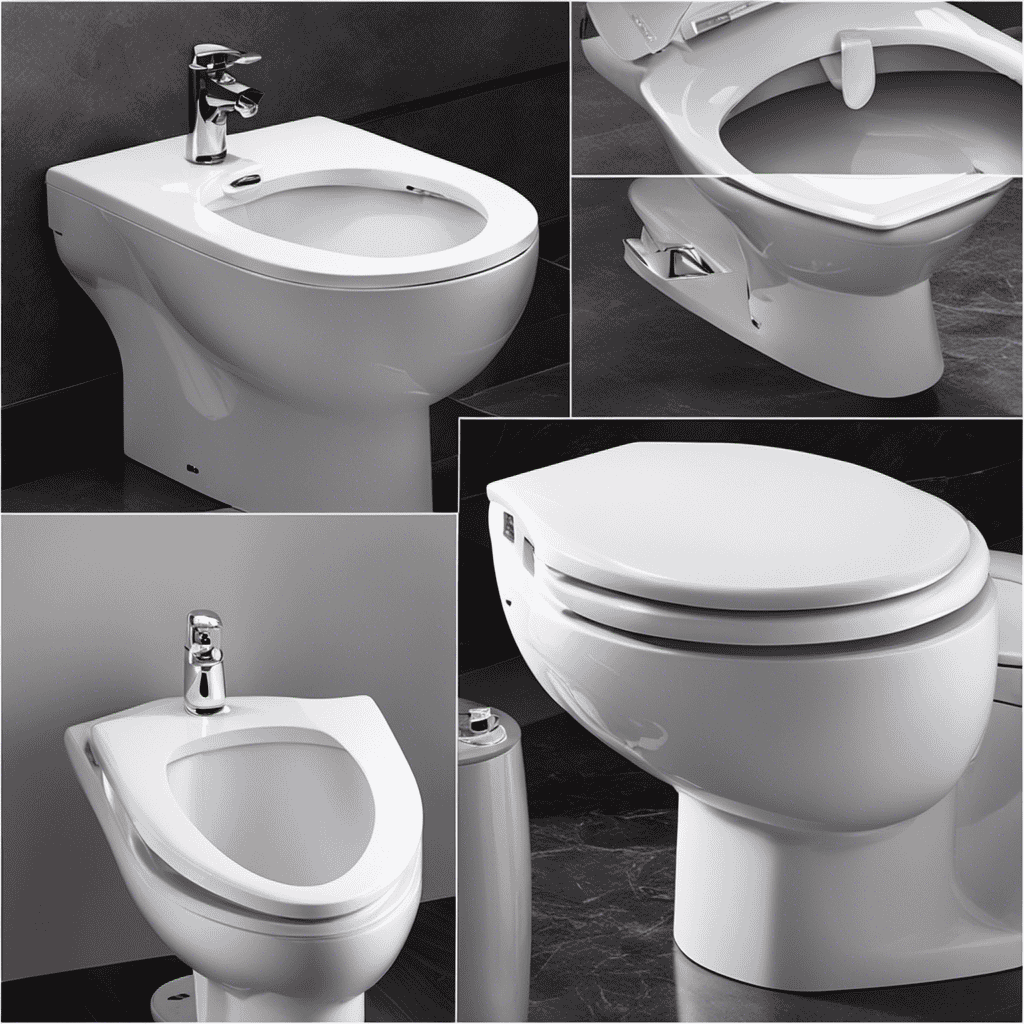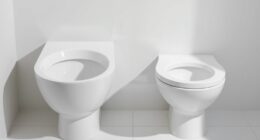I’ve been there before – standing in the bathroom, staring at a malfunctioning toilet, feeling overwhelmed and frustrated. But fear not! I’m here to guide you through the process of fixing your toilet.
In this article, I’ll share practical steps and tips to help you identify the problem, gather the necessary tools and materials, and confidently tackle common toilet issues like leaks, clogs, and broken components.
With a little know-how, you’ll be the hero of your bathroom in no time.
Key Takeaways
- Check for clogs in the trap or drainpipe using a plunger, and if necessary, use a toilet auger/snake for more stubborn clogs.
- Inspect the flapper valve for damage or debris and replace if necessary to fix a leaky toilet.
- Shut off the water supply using the appropriate type of water shut-off valve (angle stop valve, ball valve, gate valve, or compression valve) located near the toilet or on the main water supply line.
- Avoid flushing large amounts of toilet paper or non-flushable items to prevent clogs in the future, and consider using alternative methods like hot water and dish soap or regular maintenance to prevent clogs.
Identifying the Problem
First, check if the toilet is clogged before attempting any repairs. Troubleshooting common toilet issues can save you time and money.
Understanding toilet anatomy is crucial in identifying the problem accurately. When the toilet doesn’t flush properly, it may be due to a clog in the trap or the drainpipe. To check for a clog, use a plunger to create suction and try flushing again. If the water level rises and drains slowly, there is likely a clog.
Another common issue is a constantly running toilet. This can be caused by a faulty flapper or a fill valve that needs adjustment. Inspect the flapper for any damage or debris and adjust the fill valve accordingly.
Gathering the Necessary Tools and Materials
Before you can start, make sure you have all the necessary tools and materials. When it comes to toilet maintenance and preventing future issues, having the right supplies on hand is crucial.
First, you’ll need a pair of rubber gloves to protect your hands from any potential mess.
Next, grab a plunger, which is essential for unclogging a toilet. Additionally, having a toilet auger or snake can be helpful for more stubborn clogs.
You’ll also want to have a bucket and a towel nearby to catch any water that may spill during the process.
Finally, it’s a good idea to keep a bottle of toilet cleaner and a toilet brush handy for regular cleaning and maintenance.
Now that you’re prepared, let’s move on to the next step: shutting off the water supply.
Shutting Off the Water Supply
Now that you have gathered all the necessary tools and materials, it’s time to shut off the water supply. This step is crucial to prevent any accidents or water damage while working on your toilet. To help you understand the process better, here is a table outlining the different types of water shut-off valves commonly found in households:
| Valve Type | Location | How to Shut Off |
|---|---|---|
| Angle Stop Valve | Behind toilet tank | Turn clockwise |
| Ball Valve | Near water meter | Turn lever clockwise |
| Gate Valve | Main water supply line | Turn handle clockwise |
| Compression Valve | Under sink or toilet | Turn handle clockwise |
By shutting off the water supply, you eliminate the risk of water flow and can safely work on troubleshooting common toilet problems or preventing toilet clogs. Once the water supply is shut off, you can move on to fixing a leaky toilet.
Transition Sentence: Now that the water supply is turned off, let’s move on to fixing a leaky toilet.
Fixing a Leaky Toilet
With the water supply shut off, you can begin addressing a leak in your toilet.
First, check if the leak is coming from the toilet tank or the toilet bowl.
If it’s the tank, inspect the bolts that hold it in place. Tighten them if they’re loose, but be careful not to overtighten and crack the tank.
If the bolts are fine, it could be a faulty flapper valve. Replace it by turning off the water supply, draining the tank, and unscrewing the old flapper. Install the new one and turn the water back on.
If the leak is from the toilet bowl, it might be a damaged wax ring. To fix this, turn off the water supply, flush the toilet, and remove it from the floor. Replace the wax ring and reinstall the toilet.
Turn the water back on and check for any remaining leaks.
Repairing a Clogged Toilet
When it comes to repairing a clogged toilet, there are a few key methods that I have found to be effective.
The first is using a plunger, which can help to create pressure and dislodge the blockage.
If that doesn’t work, using a toilet auger can be a more powerful option, as it can reach further into the pipes to clear the clog.
For those who prefer a DIY approach, there are also various methods for toilet blockage removal that can be tried before calling a professional.
Unclogging Toilet With Plunger
To unclog the toilet with a plunger, make sure the rubber cup is covering the drain completely. Apply downward pressure and then pull up forcefully, creating suction to dislodge the blockage. Repeat this plunging motion until the water starts to drain properly. If the plunger doesn’t work, there are alternative methods you can try to unclog a toilet. One option is using a toilet auger, which is a tool designed specifically for clearing toilet clogs. Another alternative is using a mixture of hot water and dish soap to break down the clog. To prevent toilet clogs in the future, it’s important to be mindful of what you flush down the toilet. Avoid flushing large amounts of toilet paper or non-flushable items. Regularly maintaining your toilet by cleaning it and checking for any signs of clogs can also help prevent future issues.
| Alternative Methods | Description | Pros |
|---|---|---|
| Toilet Auger | A tool with a flexible cable that can reach further into the drain | Effective for tough clogs |
| Hot Water and Dish Soap | A mixture that can break down the clog | Simple and inexpensive |
| Regular Maintenance | Cleaning and checking for clogs | Preventive measure to avoid future issues |
Using Toilet Auger
If you’re dealing with a stubborn clog, try using a toilet auger to reach further into the drain and effectively clear the blockage.
A toilet auger, also known as a snake, is a long, flexible tool that can navigate through the twists and turns of your toilet’s pipes.
To use a toilet auger, start by extending the cable into the drain until you feel resistance. Then, rotate the handle clockwise to break up the clog.
If the clog doesn’t clear right away, you can try pulling back the auger and repeating the process. Remember to use the toilet auger gently to avoid damaging the porcelain.
Regular toilet maintenance, including using a snake when needed, can help prevent future clogs and keep your toilet running smoothly.
DIY Toilet Blockage Removal
After attempting to unclog my toilet with a toilet auger, I realized that sometimes the blockage can be too stubborn to remove with this method. In such cases, it’s time to resort to some DIY toilet blockage removal techniques.
These methods can help prevent a potential toilet overflow and troubleshoot common toilet issues.
Here are some practical steps to tackle a stubborn toilet blockage:
-
Use a plunger: Start by creating a tight seal around the drain and vigorously plunge up and down. This can help dislodge the blockage and restore normal flow.
-
Make a homemade drain cleaner: Mix equal parts baking soda and vinegar and pour it down the toilet. Let it sit for about 30 minutes and then flush with hot water. The chemical reaction can break down the blockage.
Replacing a Broken Toilet Component
First, check if the flapper valve is causing the issue with your toilet and if it needs to be replaced. The flapper valve is a small, rubber piece located at the bottom of the toilet tank. It is responsible for controlling the water flow during a flush.
If the flapper valve is worn out or damaged, it can lead to a weak or incomplete flush. To replace the flapper valve, start by shutting off the water supply to the toilet. Then, remove the old flapper valve by detaching it from the flush chain.
Install the new flapper valve by attaching it to the flush chain and making sure it fits securely. Finally, turn the water supply back on and test the flush to ensure it’s working properly.
Frequently Asked Questions
How Much Does It Cost to Fix a Toilet?
To fix a toilet, costs vary depending on the issue and whether you hire toilet repair services or opt for DIY. It’s important to consider factors such as parts, labor, and potential additional expenses.
Can I Use Regular Household Tools to Fix a Toilet?
Sure, I can use regular household tools to fix a toilet. Many common toilet problems like clogged drains or loose bolts can be easily resolved with a plunger, wrench, or screwdriver.
How Long Does It Typically Take to Fix a Leaky Toilet?
On average, fixing a leaky toilet can take anywhere from 30 minutes to a few hours, depending on the severity of the issue. Troubleshooting common toilet leaks involves identifying the source and replacing faulty parts.
Are There Any Temporary Solutions for a Clogged Toilet?
There are temporary fixes and DIY solutions for a clogged toilet. They can provide quick relief until a professional can assess the problem. These solutions often involve using a plunger or a toilet auger.
What Should I Do if the Toilet Is Still Leaking After Attempting to Fix It?
If the toilet is still leaking after my attempts to fix it, I would recommend calling a professional plumber for a toilet repair service. They have the expertise to properly diagnose and fix the issue.
Conclusion
In conclusion, fixing a toilet can be a simple and practical task if you follow the right steps.
By identifying the problem, gathering the necessary tools and materials, and shutting off the water supply, you can effectively address any issues with your toilet.
Whether it’s repairing a leaky toilet or unclogging a toilet, taking the time to fix these problems can save you time and money in the long run.
Remember, replacing a broken toilet component may also be necessary, but with a little knowledge and effort, you can tackle this task with ease.










